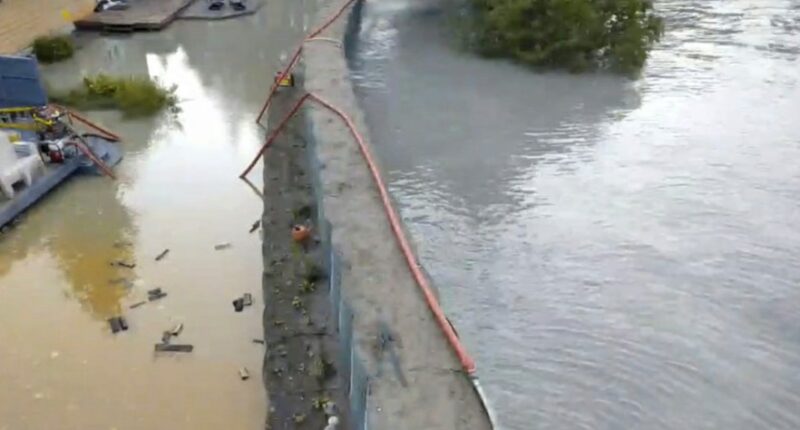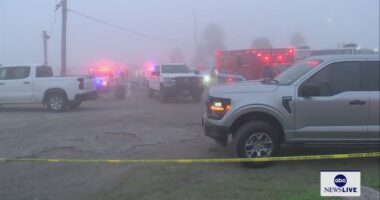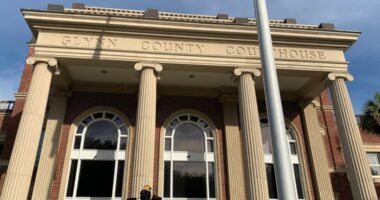Share this @internewscast.com

The annual glacial flooding that has residents of Alaska’s capital city on alert can be traced to the stunning river that flows from the nearby Mendenhall Glacier.
To the relief of Juneau’s residents, a large wall of strengthened sandbags, built with the assistance of the U.S. Army Corps of Engineers, managed to contain the worst of the floods this year. This was a stark contrast to the devastation of the past two years when unrestrained flooding led to some homes being swept away.
However, this wall is only a temporary solution. Creating a lasting solution is challenging due to uncertainties about how human-driven global warming will influence the annual water surges from a glacier ice dam. Juneau is among numerous communities worldwide trying to mitigate severe climate change impacts.
“Continuously relying on temporary measures isn’t sustainable,” stated Ann Wilkinson Lind, a resident along the Mendenhall River. “A durable solution like a levee is necessary. … This is an urgent concern that cannot afford years of prolonged studies. Immediate action is required.”
Located about 12 miles (19 kilometers) from Juneau’s urban center, with a population of 30,000, the Mendenhall Glacier is a favorite among tourists due to its accessibility via walking paths. Some residences on the city’s perimeter lie mere miles from Mendenhall Lake, at the glacier’s base, with many directly facing the Mendenhall River.
The flooding events from the Mendenhall are linked to climate change, which is causing glaciers worldwide to thin. An adjacent glacier’s retreat created a substantial basin—Suicide Basin—that accumulates rainwater and snowmelt each spring and summer, held back by the Mendenhall.
When that water builds up enough pressure, it forces its way under or around the ice dam, enters Mendenhall Lake, and flows down the Mendenhall River toward Juneau. Flooding from the basin has been an annual concern since 2011 and has gotten worse, with new water-level records being set each of the last three years.
City officials responded this year by working with state, federal and tribal entities to install the temporary barrier along roughly 2.5 miles (4 kilometers) of riverbank. The 10,000 “Hesco” barriers are essentially giant, reinforced sandbags intended to protect more than 460 properties, said emergency manager Ryan O’Shaughnessy.
The Juneau Assembly required homeowners in the flood zone to cover 40% of the barrier’s cost — about $6,300 each over 10 years. Additionally, a handful of homeowners were asked to chip in $50,000 toward reinforcing the river bank. About one-quarter of the residents formally objected, not enough to torpedo the project.
This week, some water seeped between the bastions or through pipes underneath them that are designed to allow water to drain from yards into the river. Valves in the pipes are supposed to prevent floodwater from entering. But officials uniformly called the project a success, while acknowledging that some homes were damaged and that the barrier needs to be further extended.
The barriers are designed to last for up to 10 years to allow time for a long-term solution. But questions abound.
The capacity of Suicide Basin seems to be growing, and scientists aren’t sure what a worst-case flood might look like. They predict that within a few decades, the Mendenhall itself will retreat far enough that it no longer acts as a dam, eliminating the risk of a flood outburst from Suicide Basin. But the persistent melting could also form other glacially dammed lakes that could function in a similar way.
“There’s still a lot to be learned,” said Nate Ramsey, Juneau’s engineering and public works deputy director. “We have to assume this will be an annual event for the next many, many years. Is something like a temporary, soil-filled basket levy the best we can do over that period of time? … We’ve got to keep looking for a long-term solution.”
The Army Corps of Engineers has nearly $5 million set aside to begin working on a long-term solution, which for now largely consists of data collection.
“It’s like trying to solve a math problem when the variables are always changing,” Army Corps Brig. Gen. Clete Goetz said Thursday. “Seeing the problem is not the hard part. Engineering the solution is the challenge. That’s what we’re here for.”
___
Johnson and Attanasio reported from Seattle. Rush reported from Portland, Oregon.

















